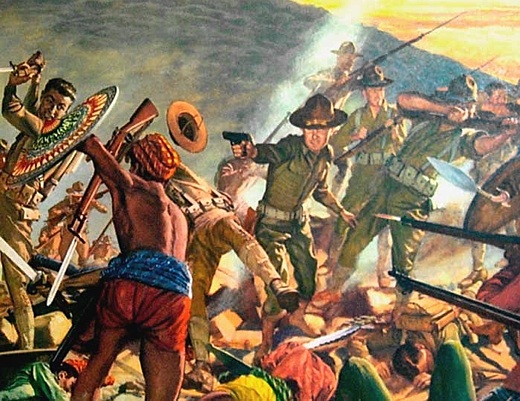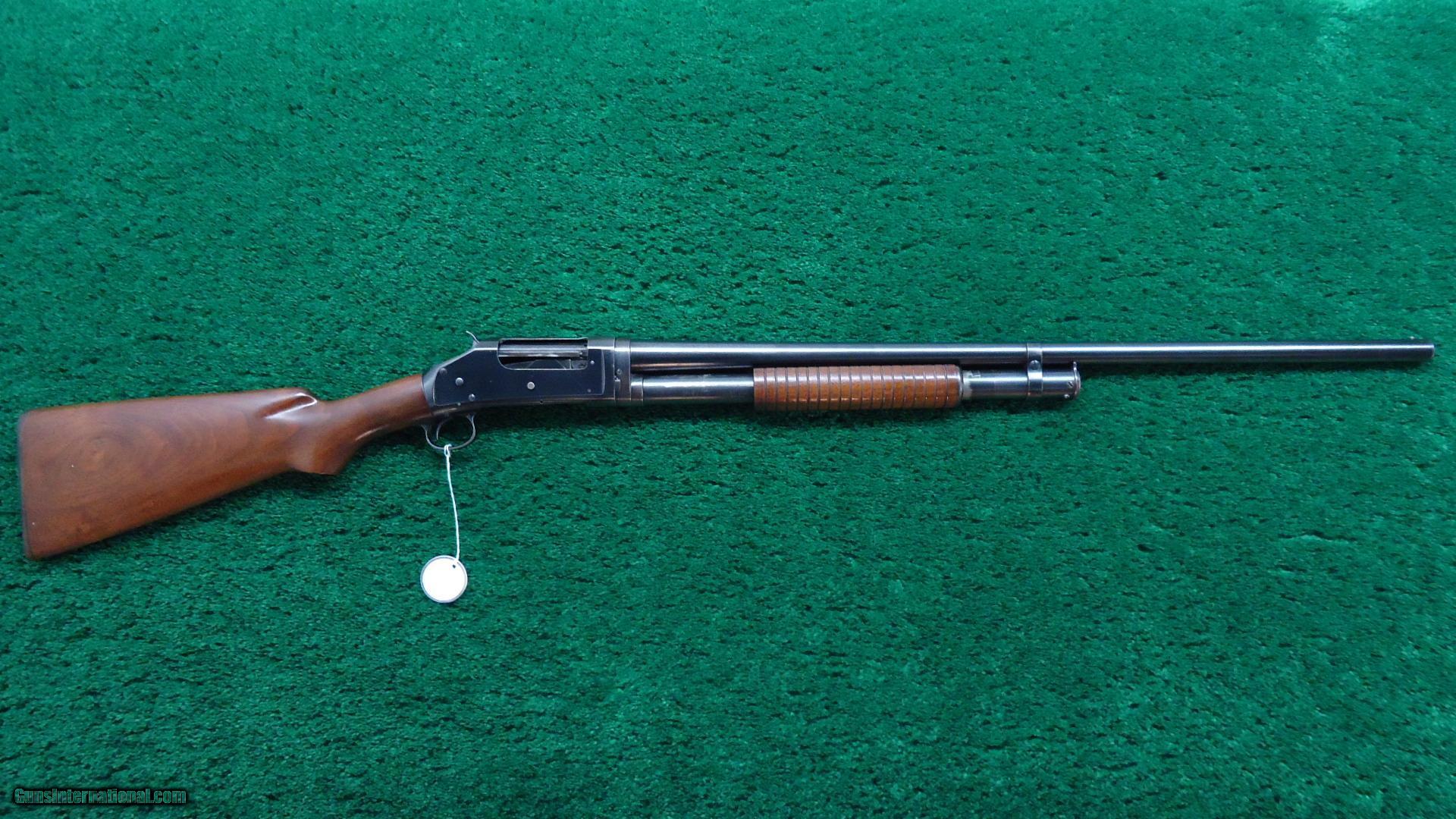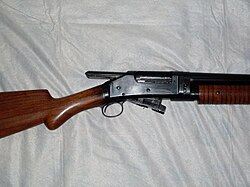
This Original Bad Boy of a Shotgun has been around now for a very long time. I am also willing to bet that it is still out there sending Buckshot down range somewhere today.
This smoothbore came of course from the Brilliant Mind of John Browning. Just like about every worthwhile firearm designed & produced in the early part of the 20th Century.

But this Shotgun was also had a few firsts after its name. The most important being that it was Winchester’s first successful pump shotgun. 
Also it was one of the most fearsome of scatter guns. In that since it did not have a disconnector in it, One could slam fire it. (Just keep the trigger depressed. Then just keep pumping it & it would fire)
So as you have no doubt guessed by now. This shotgun was a big win for Winchester. Then things got even better for the Company.
As the Army having found out that it’s small arms were not effective enough against the Moros & Mexican Bandits. So following the tradition of Americans taking shotguns into combat. (Confederate Cavalry used Shotguns in the War between the States)


So the Army put out an order for a batch of them. With a heat shield on it that allowed you to fix a Bayonet to it.
(That would scare me pretty good. If someone came at me with one!)
Where they were soon after then put to good use.


Followed by when the Army started issuing Brass Shotgun shells. Which could take the Humidity of some combat zones. Then your average GI was really cooking with gas in a firefight.
Also with the take down model. You could very easily put this gun in a standard suitcase. As Bonnie & Clyde & other Gangsters could & did back in the 30’s.
The other nice thing about this gun. Is the exposed Hammer. Which can tell one with just a glance. If the weapon is cocked.

*********************************************** Here is some hard earned experience based advice. When you shot this puppy! DO NOT DRAPE YOUR THUMB OVER THE PISTOL GRIP!!! LIKE YOU WOULD WITH A RIFLE.
Here is some hard earned experience based advice. When you shot this puppy! DO NOT DRAPE YOUR THUMB OVER THE PISTOL GRIP!!! LIKE YOU WOULD WITH A RIFLE.
As the bolt will come back and take a chunk of meat out of your hand!
Here is some more information about this awesome Shotgun!
Thanks for reading this
Grumpy
Winchester Model 1897
| Winchester Model 1897 shotgun | |
|---|---|

Winchester Model 1897
|
|
| Type | Shotgun |
| Place of origin | United States |
| Service history | |
| In service | 1897–present |
| Used by | United States Army United States Navy United States Marine Corps |
| Wars | Philippine–American War World War I Irish war of independence World War II Korean War Vietnam War Gulf War |
| Production history | |
| Designer | John Browning |
| Manufacturer | Winchester Repeating Arms Company Norinco |
| Produced | 1897–1957 |
| No. built | 1,024,700 |
| Variants | See text |
| Specifications | |
| Weight | 8 lb (3.6 kg) |
| Length | 39 1⁄4 in (1,000 mm) |
| Barrel length | 20 in (510 mm) |
|
|
|
| Caliber | 12-gauge, 16 gauge |
| Action | Pump-action |
| Effective firing range | 22 yards (20 meters)[citation needed] |
| Feed system | 5+1-round tubular magazine |
The Winchester Model 1897, also known as the Model 97, M97, or Trench Gun, was a pump-action shotgun with an external hammer and tube magazine manufactured by the Winchester Repeating Arms Company. The Model 1897 was an evolution of the Winchester Model 1893 designed by John Browning. From 1897 until 1957, over one million of these shotguns were produced. The Model 1897 was offered in numerous barrel lengths and grades, chambered in 12 and 16 gauge, and as a solid frame or takedown. The 16-gauge guns had a standard barrel length of 28 inches, while 12-gauge guns were furnished with 30-inch length barrels. Special length barrels could be ordered in lengths as short as 20 inches, and as long as 36 inches. Since the time the Model 1897 was first manufactured it has been used by American soldiers,[1] police departments,[2] and hunters.[2]
Contents
[hide]
History[edit]
The Winchester Model 1897 was designed by American firearms inventor John Moses Browning. The Model 1897 was first listed for sale in the November 1897 Winchester catalog as a 12 gauge solid frame. However, the 12 gauge takedown was added in October 1898, and the 16 gauge takedown in February 1900.[3] Originally produced as a tougher, stronger and more improved version of the Winchester 1893, itself an improvement on the early Spencer pump gun, the 1897 was identical to its forerunner, except that the receiver was thicker and allowed for use of smokeless powder shells, which were not common at the time. The 1897 introduced a “take down” design, where the barrel could be taken off; a standard in pump shotguns made today, like the Remington 870 and Mossberg 500 series. Over time, “the model 97 became the most popular shotgun on the American market and established a standard of performance by which other kinds and makes of shotguns were judged, including the most expensive imported articles”.[2] The Winchester Model 1897 was in production from 1897 until 1957. It was in this time frame that the “modern” hammerless designs became common, like the Winchester Model 1912 and the Remington 870 and the Model 1897 was superseded by the Winchester Model 1912.[4] However, the gun can still be found today in regular use.
Improvements from the 1893[edit]
While designing the new Model 1897, many of the weaknesses present in the earlier Model 1893 were taken into account and remedied.[3] These improvements included:
- The frame was strengthened and made longer to handle a 12 gauge 2¾-inch shell, as well as the 2⅝-inch shell.[3]
- The top of the frame was covered so that the ejection of the fired shell was entirely from the side.[3] This added a great amount of strength to the frame of the gun and it allowed the use of a 2¾ inch shell without the danger of the gun constantly jamming.[5]
- The action could not be opened until a slight forward movement of the slide handle released the action slide lock. In firing, the recoil of the shotgun gave a slight forward motion to the slide handle and released the action slide lock which enabled immediate opening of the action. In the absence of any recoil, the slide handle had to be pushed forward manually in order to release the action slide lock.[3]
- A movable cartridge guide was placed on the right side of the carrier block to prevent the escape of the shell when the shotgun was turned sideways in the act of loading.[3]
- The stock was made longer and with less drop.[3]
Of these improvements, the slide lock is the one that made the Model 1897 into a safe firearm. This improved slide lock kept the shotgun locked until actual firing occurred which prevented it from jamming in the case of a misfire. The slide lock “stands in such a relation to the body of the firing pin as will prevent the firing pin reaching the primer until the pin has moved forward a sufficient distance to insure locking of the breech bolt.”[6] This prevents the action sleeve “from being retracted by the hand of the gunner until after firing, and hence rendering the firearm more safe”[7]
Description[edit]
The Winchester Model 1897 and the Winchester Model 1893 were both designed by John Browning. The Model 1897 is an external hammer shotgun lacking a trigger disconnector. This means that the user can hold the trigger down while cycling the shotgun and once the action is returned to battery the shotgun fires.[8] The firearm itself is classified as a slide action pump shotgun. It was the first truly successful pump-action shotgun produced. Throughout the time period the Model 1897 was in production, over a million of the type were produced in various grades and barrel lengths. 16-gauge guns had a standard barrel length of 28 inches, while 12-gauge guns were furnished with 30-inch length barrels. Special length barrels could be ordered in lengths as short as 20 inches, and as long as 36 inches. Along with various grades and barrel lengths, the Model 1897 came in two different chamberings. One was the 12 gauge and the other was the 16 gauge.[8] The shells should be of the 2-¾ inch or 2-⅝ inch model.[3] Any shells larger are not recommended. An average Model 1897 can hold 5 shotgun shells in the magazine tube. However, this could vary from grade to grade.[9] When working the action of the Model 1897 the forend (fore grip) is pulled back, forcing the breech bolt to the rear which extracts and then ejects the spent shell while simultaneously cocking the external hammer by pushing it to the rear. When the forend is slid forward again, the breech bolt pushes a fresh shell into the gun’s chamber and locks into place.
The Chinese company Norinco has made an effort to reproduce this firearm. The Norinco 97 is an almost exact copy of the Winchester 1897, produced in both Trench and Riot grades, yet lacking in the fit and finish of the originals.[1]
Grades of the Model 97[edit]
| Grade | Gauge | Barrel (inches) | Production dates | Remarks |
| Standard | 12,16 | 30,28 | 1897–1957[11] | Plain walnut stock with steel buttplate |
| Trap | 12,16 | 30,28 | 1897–1931[11] | Fancy walnut with checkering |
| Pigeon | 12,16 | 28 | 1897–1939[11] | Same as Trap, but hand-engraved receiver |
| Tournament | 12 | 30 | 1910-–1931[12] | Select walnut; receiver top matte to reduce glare |
| Brush | 12,16 | 26 | 1897–1931[11] | Shorter magazine, plain walnut without checkering, solid frame |
| Brush Takedown | 12,16 | 26 | 1897–1931[11] | As above, but takedown frame |
| Riot | 12 | 20 | 1898–1935[11] | Plain walnut, solid or takedown frame |
| Trench | 12 | 20 | 1917–1945[13] | Same as riot gun but with heat shield, bayonet lug, and sling swivels |
Original Prices[edit]
When the Model 1897 was first introduced, the price depended upon what grade was being purchased and what features were being added to that specific shotgun. To purchase a plain finished shotgun would cost the buyer $25, whereas an engraved receiver with checkered and finer wood included cost $100.[8] The more expensive grades of the Model 1897 were the standard, trap, pigeon, and tournament grades. These were the grades that were normally equipped with an engraved receiver and with checkered, finer wood.[4][14] The less expensive and plainer grades were the Brush, Brush Takedown, Riot, and Trench. These grades were not given the higher valued wood or special designs.[4][14] This is because these guns were designed and built for hard abuse. These grades stood a higher chance of being badly damaged so there was no need to put extra money into them for appearance purposes. As the functions that were performed with these grades required them to be lightweight, it was not beneficial to use heavy and expensive wood when designing them. Most often, when these grades were purchased, they were purchased in high numbers. By designing these grades with standard wood and finish, it kept the prices at a lower level.[4][14]
Military use[edit]
The Model 1897 was popular before World War I, but it was after the war broke out that sales of the Model 1897 picked up. This was because many were produced to meet the demands of the Military. When the United States entered World War I, there was a need for more service weapons to be issued to the troops. It became clear to the United States just how brutal trench warfare was, and how great the need was for a large amount of close-range firepower while fighting in a trench, after they had observed the war for the first three years.[1] The Model 1897 Trench grade was an evolution of this idea. The pre-existing Winchester Model 1897 was modified by adding a perforated steel heat shield over the barrel which protected the hand of the user from the barrel when it became over-heated,[15] and an adapter with bayonet lug for affixing an M1917 bayonet.[1]
This model was ideal for close combat and was efficient in trench warfare due to its 20 inch cylinder bore barrel. Buckshot ammunition was issued with the trench grade during the war. Each round of this ammunition contained nine 00 (.33-caliber) buckshot pellets. This gave considerable firepower to the individual soldier by each round that was fired.[2] This shorter barrel and large amount of firepower is what made this grade ideal for trench warfare.
The Model 1897 was used by American troops for purposes in World War Iother than a force multiplier. American soldiers who were skilled at trap shooting were armed with these guns and stationed where they could fire at enemy hand grenades in midair.[2] This would deflect the grenades from falling into the American trenches and therefore protect American soldiers.[2]
Unlike most modern pump-action shotguns, the Winchester Model 1897 (versions of which were type classified as the Model 97 or M97 for short) fired each time the action closed with the trigger depressed (that is, it lacks a trigger disconnector). Coupled with its six-shot capacity made it effective for close combat, such that troops referred to it as a “trench sweeper”. This characteristic allowed troops to fire the whole magazine with great speed. The Model 1897 was so effective, and feared, that the German government protested (in vain) to have it outlawed in combat.[16] The Model 1897 was used again in World War II by the United States Army and Marine Corps, where it was used alongside the similarly militarized version of the hammerless Model 1912.
Other military uses of the shotgun included “the execution of security/interior guard operations, rear area security operations, guarding prisoners of war, raids, ambushes, military operations in urban terrain, and selected special operations.”[16]
World War I protests[edit]
Although the Model 1897 was popular with American troops in World War I, the Germans soon began to protest its use in combat. “On 19 September 1918, the German government issued a diplomatic protest against the American use of shotguns, alleging that the shotgun was prohibited by the law of war.”[16] A part of the German protest read that “[i]t is especially forbidden to employ arms, projections, or materials calculated to cause unnecessary suffering” as defined in the 1907 Hague Convention on Land Warfare.[2] This is the only known occasion in which the legality of actual combat use of the shotgun has been raised.[16] However, the United States interpreted their use of the shotgun differently than Germany. The Judge Advocate General of the Army, Secretary of State Robert Lansing carefully considered and reviewed the applicable law and promptly rejected the German protest.[16] France and Britain considered using shotguns as trench warfare weapons during World War I. The shotgun in question was a double-barreled shotgun, which was not used because they were unable to obtain high powered ammunition and that type of gun is slow to reload in close combat.[16]
German Response[edit]
The rejection of their protest greatly upset the German forces, because they believed they were treated unjustly in the war. Shortly after the protest was rejected, Germany issued threats that they would punish all captured American soldiers that were found to be armed with a shotgun.[2] This led to the United States issuing a retaliation threat, stating that any measures unjustly taken against captured American soldiers would lead to an equal act by the United States on captured German soldiers.[17]
Other uses[edit]
After the war, a shorter-barrelled version of the Model 1897 was marketed by Winchester as a riot gun. Messengers of The American Express Company were armed with this weapon as were various police departments throughout the US.[2] The differences between this riot version and the trench version were the riot version lacked the heat shield and bayonet lug,[1]and all trench guns were equipped with sling swivels, whereas most riot guns were not.[8]







